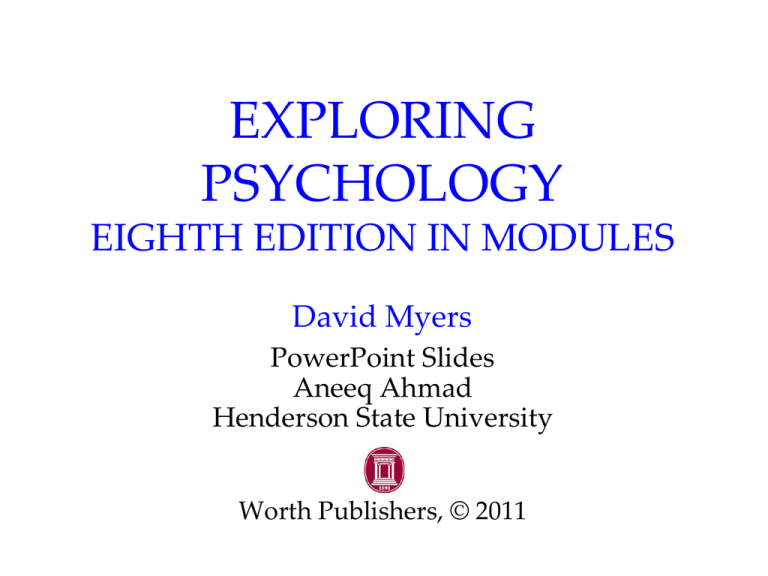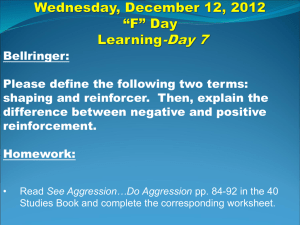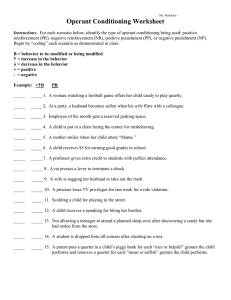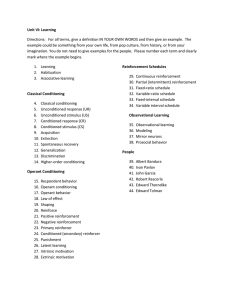Memory
advertisement

EXPLORING PSYCHOLOGY EIGHTH EDITION IN MODULES David Myers PowerPoint Slides Aneeq Ahmad Henderson State University Worth Publishers, © 2011 Learning 2 Operant Conditioning Module 18 3 Skinner’s Experiments Shaping Behavior Types of Reinforcers Reinforcement Schedules Punishment Extending Skinner’s Understanding Cognition and Operant Conditioning Biological Predispositions 4 Skinner’s Legacy Applications of Operant Conditioning CLOSE-UP: Training Our Partners Contrasting Classical & Operant Conditioning 5 Operant & Classical Conditioning Classical conditioning and operant conditioning are both forms of associative learning, but there are key differences. Classical conditioning forms associations between stimuli (CS and US). Operant conditioning, on the other hand, forms an association between behaviors and the resulting events. Classical conditioning involves respondent behavior that occurs as an automatic response to a certain stimulus. Operant conditioning involves operant behavior, a behavior that operates on the environment, producing rewarding or punishing stimuli. 6 Skinner’s Experiments Skinner’s experiments extend Thorndike’s thinking, especially his law of effect. This law states that rewarded behavior is likely to occur again. Yale University Library 7 Operant Chamber Using Thorndike's law of effect as a starting point, Skinner developed the operant chamber, or the Skinner box, to study operant conditioning. The box has a bar or key that an animal manipulates to obtain a reward like food or water. 8 Shaping Shaping is the operant conditioning procedure in which reinforcers guide behavior towards the desired target behavior through successive approximations. A rat shaped to sniff mines. A manatee shaped to discriminate objects of different shapes, colors and sizes. 9 Types of Reinforcers Reinforcer: Any event that strengthens the behavior it follows. Positive reinforcement increases a behavior by presenting a pleasurable stimulus after the response. Negative reinforcement increases a behavior by stopping or removing a negative stimulus. A heat lamp positively reinforces a 10 meerkat’s behavior in the cold. Primary & Conditioned Reinforcers Primary Reinforcer: An innately reinforcing stimulus like food or drink. Conditioned Reinforcer: A learned reinforcer that gets its reinforcing power through association with the primary reinforcer. 11 Immediate & Delayed Reinforcers Immediate Reinforcer: A reinforcer that occurs instantly after a behavior. A rat gets a food pellet for a bar press. If there is a delay of more than 30 seconds, the rat will not learn to press the bar. Delayed Reinforcer: A reinforcer that is delayed in time for a certain behavior. A paycheck that comes at the end of a week. We may be inclined to engage in small immediate reinforcers (watching TV) rather than large delayed reinforcers (getting an A in a course) which require consistent study. 12 Reinforcement Schedules Continuous Reinforcement: Reinforces the desired response each time it occurs. Partial Reinforcement: Reinforces a response only part of the time. Though this results in slower acquisition in the beginning, it shows greater resistance to extinction later on. Fixed-ratio schedule: Reinforces a response only after a specified number of responses. e.g., piecework pay. Variable-ratio schedule: Reinforces a response after an unpredictable number of responses. This is hard to extinguish because of the unpredictability. (e.g., behaviors like gambling, fishing.) 13 Reinforcement Schedules Fixed-interval schedule: Reinforces a response only after a specified time has elapsed. (e.g., preparing for an exam only when the exam draws close.) Variable-interval schedule: Reinforces a response at unpredictable time intervals, which produces slow, steady responses. (e.g., pop quiz.) 14 Schedules of Reinforcement 15 Punishment A punisher is any consequence that decreases the behavior it follows. 16 Punishment In relation to parenting and physical punishment of children, these four drawbacks have been found. 1. Punished behavior is suppressed, not forgotten. 2. Punishment teaches discrimination. 3. Punishment can teach fear. 4. Physical punishment may increase aggressiveness by modeling aggression as a way to cope with problems. 17 Extending Skinner’s Understanding Skinner believed in inner thought processes and biological underpinnings, but many psychologists criticize him for discounting them. 18 Cognition & Operant Conditioning Evidence of cognitive processes during operant learning comes from rats during a maze exploration in which they navigate the maze without an obvious reward. Rats seem to develop cognitive maps, or mental representations, of the layout of the maze (environment). Such cognitive maps are based on latent learning, which becomes apparent only when an incentive is given (Tolman & Honzik, 1930). 19 Biological Predisposition Biological constraints predispose organisms to learn associations that are naturally adaptive. Breland and Breland (1961) showed that animals drift towards their biologically predisposed instinctive behaviors. Animals can most easily learn and retain behaviors that draw on their biological predispositions 20 Skinner’s Legacy Skinner argued that behaviors were shaped by external influences instead of inner thoughts and feelings. Critics argued that Skinner dehumanized people by neglecting their free will. Falk/ Photo Researchers, Inc . 21 Applications of Operant Conditioning Skinner introduced the concept of teaching machines that shape learning in small steps and provide reinforcements for correct rewards. 22 In School Applications of Operant Conditioning In sports, reinforcement has been used to teach golf and baseball skills by rewarding successively larger achievements, e.g. longer putts, or pitches from further out. At work, reinforcers affect productivity. Many companies now allow employees to share profits and participate in company ownership. 23 Applications of Operant Conditioning At home, with our children, reinforcing good behavior increases the occurrence of these behaviors. Ignoring unwanted behavior decreases their occurrence. We can use operant conditioning in our own lives by: 1. Stating your goal 2. Monitoring how often you engage in your desired behavior 3. Reinforcing the desired behavior 24 4. Gradually reducing your rewards Contrasting Classical and Operant Conditioning 25







